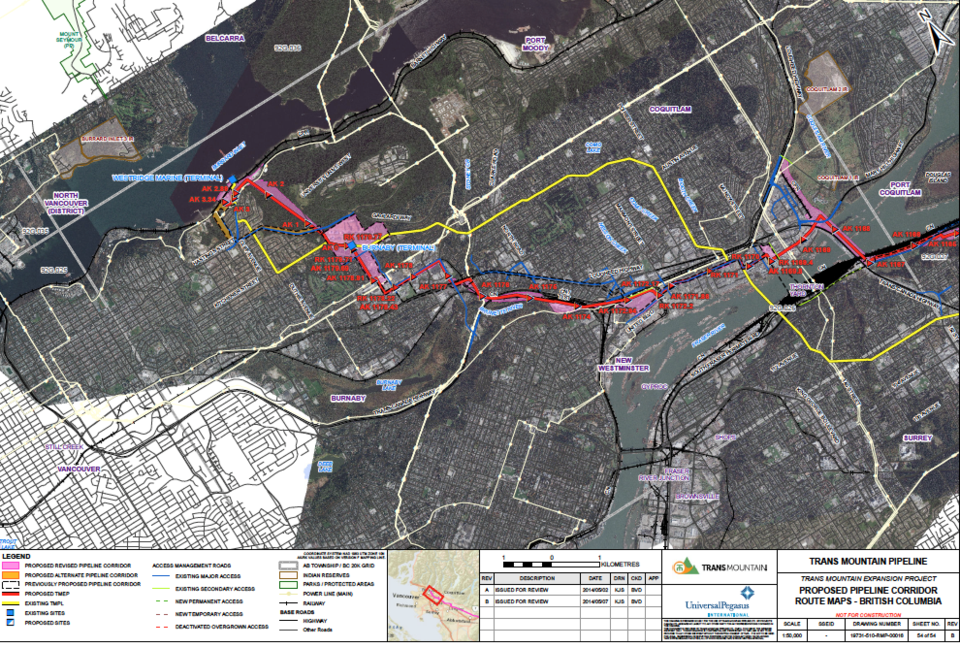The City of New Westminster is worried that a catastrophic pipeline rupture could pose tremendous environmental impacts on the Brunette and Fraser River.
That’s one of the reasons the city applied for intervener status for the Kinder Morgan application to the National Energy Board. Kinder Morgan is proposing to twin the Trans Mountain pipeline, which would run between Burnaby and Edmonton and would triple the company’s capacity to carry diluted bitumen from the Alberta tar sands.
According to a staff report, the current selected alignment crosses the Fraser River near the Port Mann Bridge and continues north before crossing west into Burnaby near Clarke Road and then northwest to the marine terminal. The “alternative” corridor being studied would run on the north side of the Brunette River from near the Coquitlam and New Westminster boundary to the New Westminster-Burnaby boundary.
The city is concerned the “alternative” pipeline route could have significant impacts on New Westminster, both during construction and in the event of a pipeline failure.
“Kinder Morgan’s submission to the National Energy Board focuses on the ‘selected’ alignment with little information on the ‘alternative’ alignment other than the approximate location,” stated a staff report by Mark Allison, the city’s manager of strategic initiatives and sustainability. “There is evidence to suggest that the ‘alternative’ alignment may actually be the preferred alignment, as it is expected that it would be easier to construct.”
Coun. Bill Harper said there’s not a lot of awareness in New Westminster about Kinder Morgan’s proposal, something he considers to be an “extremely important” issue for the city. He’s pleased the city will be part of the process, and will work with neighbouring cities on the matter.
The city has been granted intervener status, which means it’s able to file written evidence, ask written questions about Trans Mountain’s and other interveners’ evidence, present written and oral arguments, file and respond to notices of motion and comment on draft conditions that are identified by the national Energy Board review panel.
In a report to council, Allison noted that Kinder Morgan’s submission to the national Energy Board was more than 15,000 pages.
“The city does not have the resources to review this material in detail or to prepare formal legal briefs,” stated the report. “Fortunately, a number of local interveners, including Metro Vancouver and the cities of Burnaby, Vancouver and Coquitlam, have many of the same concerns as New Westminster and have expressed a willingness to work with us and share information.”
New Westminster will be focusing on issues that most directly relates to the city – the Brunette River watershed, the Braid industrial area and the Fraser River. After receiving some requested information from Kinder Morgan, city staff plan to meet with organizations such as Douglas College, New Westminster Environmental Partners, and the Sapperton Fish and Game Club.
“Protection and enhancement of the limited remaining natural habitat is a key objective of Envision 2032, the city’s sustainability framework,” stated the staff report. “As recent history has shown, in spite of current practices and regulations, pipeline spills are a regular occurrence, sometimes with catastrophic impacts on local ecosystems and watersheds, which are already fragile in this area. According to a number of sources, there are numerous potential risks to pipelines and concerns over the state of spill response capability on the B.C. coast that need to be addressed.”
Kinder Morgan believes its application addresses all issues previously identified by the National Energy Board, including environmental, socio-economic, Aboriginal engagement, marine risk assessments and engineering components of the proposed expansion project.



